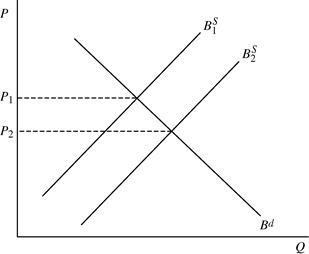
1.
(a) More, because the bonds have become more
liquid; (b) more, because their expected return has risen relative to
stocks; (c) less, because they have become less liquid relative to stocks; (d)
less, because their expected return has fallen; (e) more, because they have
become more liquid.
2. When
the Fed sells bonds to the public, it increases the supply of bonds, thus
shifting the supply curve
Bs
to the right. The result is that the intersection of the supply and demand
curves Bs
and Bd
occurs at a lower price and a higher equilibrium interest rate, and the
interest rate rises. With the liquidity preference framework, the decrease in
the money supply shifts the money supply curve
Ms
to the left, and the equilibrium interest
rate rises. The answer from bond supply and demand analysis is consistent
with the answer from the liquidity preference framework.


3. When
the price level rises, the quantity of money in real terms falls (holding the
nominal supply of money constant); to
restore their holdings of money in real terms to their former level, people will
want to hold a greater nominal quantity of money. Thus the money demand
curve Md shifts to the
right, and the interest rate rises.
5.
Interest rates would rise. A sudden increase in people’s expectations of
future real estate prices raises the expected return on real estate relative to
bonds, so the demand for bonds falls. The demand curve
Bd shifts to the left,
bond prices fall, and the equilibrium interest rate rises.
6. Interest rates should rise. The large federal
deficits require the Treasury to issue more bonds; thus the
supply of bonds increases. The supply curve,
Bs, shifts to the right and the equilibrium interest rate
rises. Some economists believe that when the Treasury issues more bonds,
the demand for bonds increases because the issue of bonds increases the public’s
wealth. If this is the case, the demand curve, Bd, will also
shift to the right, and it is no longer clear that the equilibrium interest rate
will rise. Thus there is some potential ambiguity in the answer to this
question.
7.
Given the answer to Question 10
above, the supply effect of large deficits should lead to higher interest
rates. The effects of the economic crisis
lead to significantly lower wealth and income, which depressed Treasury
bond demand, but also decreased corporate bond supply by even more because
investment opportunities collapsed. The larger leftward shift in the bond supply
curve than the rightward shift in the bond
demand curve would then result in a rise in bond prices and a fall in interest
rates. In addition, due to the severity of the global crisis, U.S.
treasury debt became a safe haven investment, reducing
relative risk and increasing liquidity for
U.S. treasury debt. This significantly raised U.S. treasury bond demand,
leading to higher bond prices and significantly lower yields. In other words,
the decrease in investment opportunities and risk factors significantly offset
the wealth effect on demand and the deficit effect on supply.
8.
Yes, interest rates will rise. The lower commission on stocks makes them
more liquid relative to bonds, and the demand for bonds will fall. The demand
curve Bd will therefore
shift to the left, and the equilibrium interest rate will rise.
9.
U.S. treasury bills have lower default risk and more liquidity than negotiable
CDs. Consequently, the demand for Treasury bills is higher, and they have a
lower interest rate.
10. During
business cycle booms, fewer corporations go bankrupt and there is less default
risk on corporate bonds, which lowers
their risk premium. Conversely, during recessions default risk on corporate
bonds increases and their risk premium increases. The risk premium on
corporate bonds is thus anticyclical, rising during recessions and falling
during booms.
11. True. When bonds of different maturities are
close substitutes, a rise in interest rates for one bond
causes the interest rates for others to rise
because the expected returns on bonds of different maturities cannot get
too far out of line.